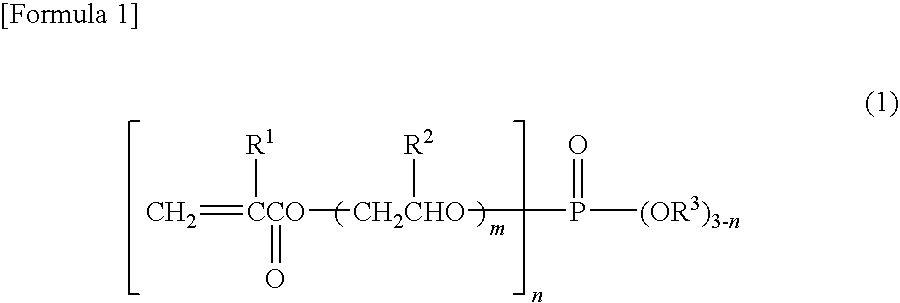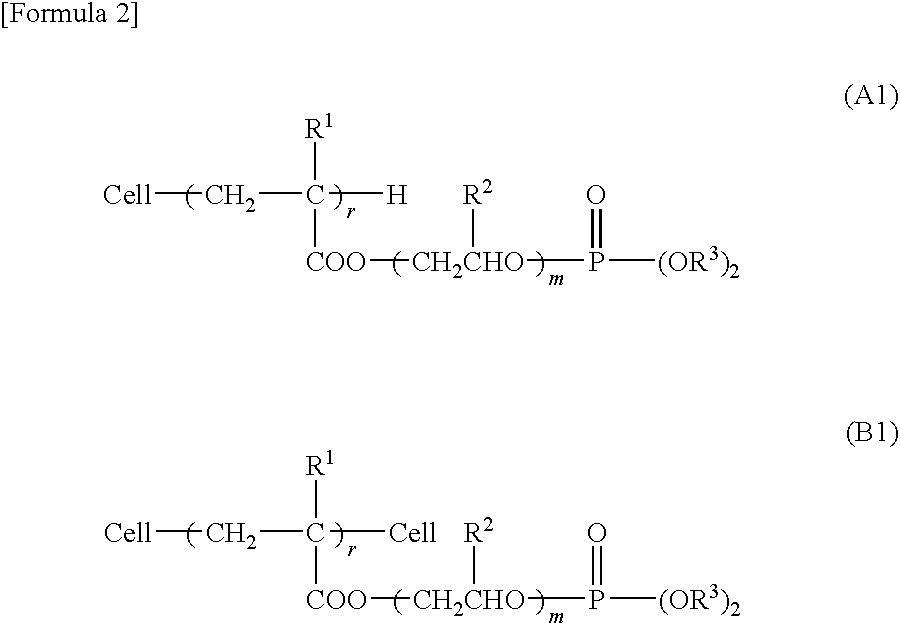Flame-retardant processing method and flame-retarded cellulosic fiber material
a cellulosic fiber and processing method technology, applied in heat resistance fibres, vegetable fibres, fibre treatment, etc., can solve the problems of insufficient flame resistance properties, no flame retardant that can be used, and high concentration of formaldehyde, so as to improve initial improve flame retardance and flame retardance, and retain the preference of hand feeling of the cellulosic fiber material. , the effect of sufficient improvemen
- Summary
- Abstract
- Description
- Claims
- Application Information
AI Technical Summary
Benefits of technology
Problems solved by technology
Method used
Image
Examples
first embodiment
[0026]The first embodiment of the present invention employs the order (1) above.
[0027]Radiation Processing Step
[0028]First in the embodiment, the fibrous material is irradiated with a radiation. The irradiation makes it possible for the radically polymerizable phosphorus-containing compound to bind to the fibrous material chemically in addition reaction of the radically polymerizable groups in the phosphorus processing step described below. The radiation treatment generates radicals on the cellulosic fiber, and the generated radicals form chemical bonds of the radically polymerizable groups of the phosphorus-containing compound with the cellulosic fiber in the phosphorus processing step. The radicals on the cellulosic fiber are generated easily at the 5th carbon, and then at the 4th and 1st carbons, of the structural unit of the cellulose molecule, and the radicals are considered to be generated also at the 2nd, 3rd and 6th carbons. The radically polymerizable phosphorus-containing ...
second embodiment
[0079]The second embodiment of the present invention employs the order (2). Hereinafter, each step in the second embodiment will be described, but the each step is identical with that in the first embodiment, except that the operational order is different, unless otherwise indicated.
[0080]Amine Processing Step
[0081]First in the embodiment, an amine compound is added to the fibrous material. The amine compound added in this step reacts rapidly with the phosphorus-containing compound regions bound to the cellulosic fiber in the subsequent radiation and also phosphorus processing steps, if it is present on the surface of the cellulosic fiber.
[0082]In the present step, an aging treatment is preferably carried out after amine treatment, by a method similar to the aging treatment in the phosphorus processing step of the first embodiment, but a water-washing treatment is preferably eliminated. It is because the water-washing treatment removes the amine compound from the fibrous material. T...
third embodiment
[0089]The third embodiment of the present invention employs the order (3). Hereinafter, each step in the third embodiment will be described, but the each step is identical with that in the first embodiment, except that the operational order is different, unless otherwise indicated.
[0090]Radiation Processing Step
[0091]First in the present embodiment, a radiation is irradiated to the fibrous material. It generates radicals on the cellulosic fiber, enabling the phosphorus-containing compound to bind chemically to the cellulosic fiber in addition reaction by the radically polymerizable groups in the single-bath processing step described below.
[0092]Single-Bath Processing Step
[0093]A phosphorus-containing compound and an amine compound are then added to the cellulosic fiber material simultaneously. The phosphorus treatment of binding the phosphorus-containing compound to the cellulosic fiber and the amine treatment of reacting the bound phosphorus-containing compound region with the amin...
PUM
| Property | Measurement | Unit |
|---|---|---|
| temperature | aaaaa | aaaaa |
| temperature | aaaaa | aaaaa |
| temperature | aaaaa | aaaaa |
Abstract
Description
Claims
Application Information
 Login to View More
Login to View More - R&D
- Intellectual Property
- Life Sciences
- Materials
- Tech Scout
- Unparalleled Data Quality
- Higher Quality Content
- 60% Fewer Hallucinations
Browse by: Latest US Patents, China's latest patents, Technical Efficacy Thesaurus, Application Domain, Technology Topic, Popular Technical Reports.
© 2025 PatSnap. All rights reserved.Legal|Privacy policy|Modern Slavery Act Transparency Statement|Sitemap|About US| Contact US: help@patsnap.com


